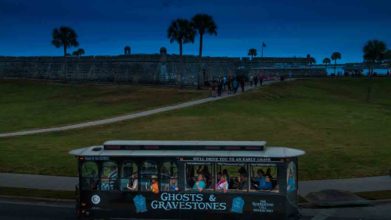St. Augustine History Unraveled

Keeping track St. Augustine’s long history as a negotiating pawn in treaties between the Spanish, British and Americans can be a challenge for most visitors. A tour of the Oldest House Museum, built the early 1700s during the First Spanish Period, altered during the British Period, and again during the 2nd Spanish Period, clears up the multi-flag confusion in an authentic way.
On a tour of the carefully restored, Spanish Colonial house, well-informed guides weave together well-researched details about architecture, period furnishings, household implements, and stories of real families who moved in and out of the house during the settlement’s multinational occupational periods. Through these documented personal connections, St. Augustine’s complicated history is unraveled.
Records show that around 1721, Tomas Gonzalez y Hernandez, a native of the Canary Islands, lived in the original, simple, one-story coquina home with his family. He was a gunner with the artillery company stationed at Castillo de San Marcos nearby. As visitors on tour walk over the coquina floor of the ground floor and look at simple period furnishing and household implements, they are able to picture daily life as it was for this family living in the early settlement.
After years of living in the home, the British occupation of St. Augustine in 1763 forced Tomas Gonzalez to sell his home and relocate his family to Cuba. An Englishman, Major John Peavett, purchased the house in 1775. He and his wife, Mary Evans Peavett, moved in and established it as a guest house and pub.
Architectural research shows that portions of the upper story of the Oldest House, as well as other improvements, were made in the years after that purchase. On tour of the second floor, visitors immediately notice that furnishings reflect the couple’s English tastes and way of life. The Peavetts did not leave St. Augustine when Spanish rule returned in 1783. Joseph died in 1786, and Mary remained in the house until she fell on hard times. The house was sold in a public auction in 1790.
The successful bidder was Geronimo Alvarez, a native of Spain. A baker by trade, he became a leading municipal officer involved in local politics. The family remained in St. Augustine after Florida was acquired by the U.S. in 1821, and the home stayed in the family for over a century.
During house tours, vivid stories of real families who lived in the Oldest House over the span of centuries give life to the historic house. They also bring clarity to the often confusing history of St. Augustine and the multiple flags flying over the Oldest House and elsewhere in the historic district.




